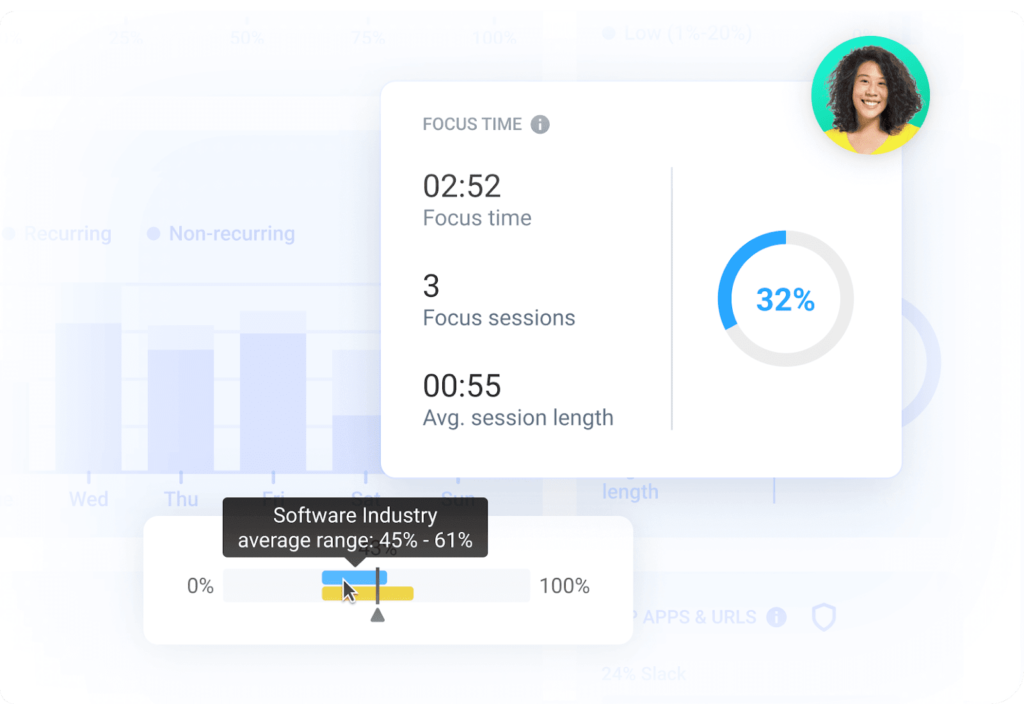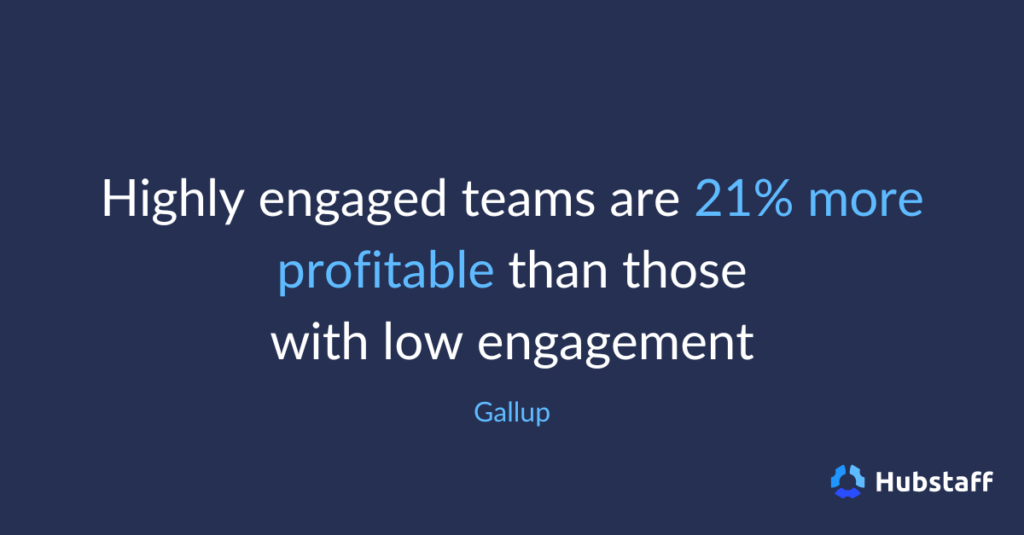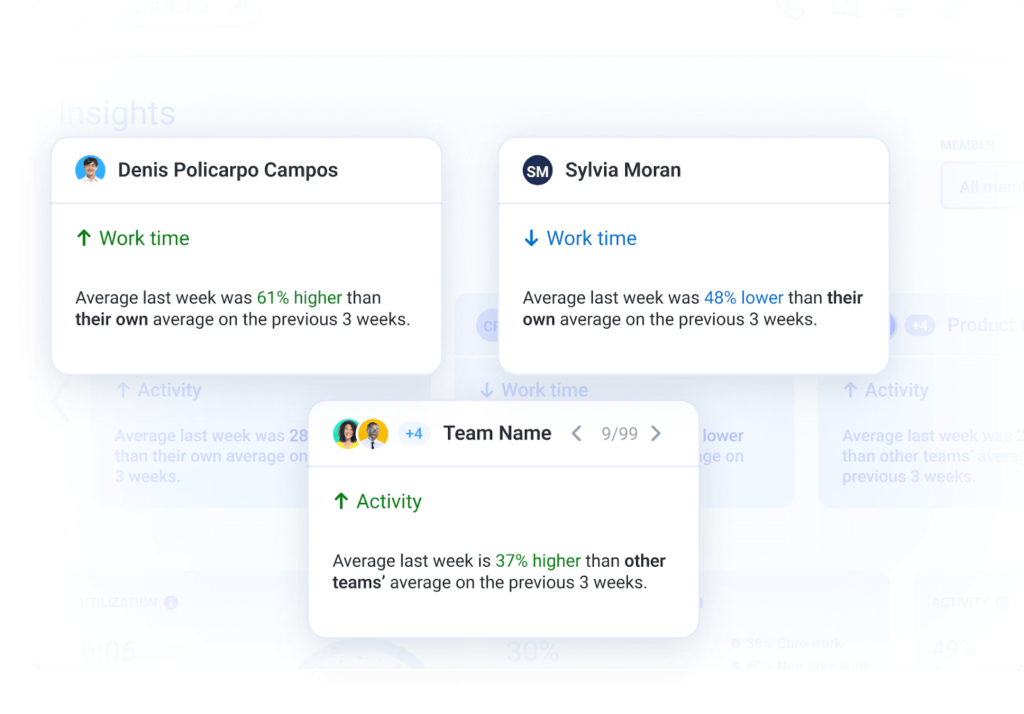Much like the elusive pursuit of happiness, the pursuit of heightened productivity and employee satisfaction continues to be a top priority for business leaders. This evasive goal demands an emphasis on workforce engagement management to find the delicate balance of technology and strategic team management.
Workforce engagement management (WEM) is a holistic approach designed to enhance employee engagement, operational efficiency, and, ultimately, organizational performance.
We’ll be your guide as you navigate Workforce Engagement Management, unveiling its potential to revolutionize how organizations can engage their most valuable asset: their employees.
Boost your team’s efficiency with Hubstaff's productivity tools
What is workforce engagement management?
Workforce Engagement Management is an approach that improves how organizations engage with their employees in order to enhance productivity, satisfaction, and efficiency.
It involves using strategies, tools, and technologies to manage and improve the workplace experience, focusing on:
- Communication
- Performance management
- Training and development
- Employee feedback and recognition
WEM is based on the premise that a more engaged workforce is more productive, innovative, and committed to company goals.

This approach goes beyond traditional workforce management (WFM), which often focuses primarily on scheduling, staffing, and compliance.
Taking WFM a step further, WEM seeks to create a more positive and supportive work environment that fosters employee engagement, enhances job satisfaction, and promotes a sense of belonging and purpose among employees.
Let’s take a closer look at what WEM entails.
Key components of workforce engagement management
- Communication tools: Facilitating open and effective communication channels between employees, management, and team members is crucial.
- Performance management: Implementing fair and transparent processes for setting expectations, monitoring performance, providing feedback, and empowering employees to grow and succeed.
- Learning and development: Offering opportunities for employees to acquire new skills and advance their careers within the organization increases engagement and improves retention.
- Employee feedback and recognition: Creating a system for regular employee feedback and recognizing and rewarding employees for their contributions. This then leads to improved morale and motivation.
- Analytics and reporting: Using data and analytics to gain insights into employee engagement levels, identify improvement areas, and measure WEM initiatives’ impact.

WEM can create a more fulfilling and engaging workplace experience that benefits employees and the organization.
Benefits of enhanced workforce engagement management
The ultimate goal of WEM is to align employee goals with organizational objectives, resulting in higher levels of employee satisfaction, reduced turnover, and improved profitability.
By focusing on mastering workforce engagement, you can significantly impact almost every aspect of your employee experience.
Here are the key benefits, backed up by data:
- Increased employee satisfaction: WEM initiatives focus on creating a positive work environment that recognizes and rewards employee contributions, fosters open communication, and supports professional development. This is important because happy employees tend to be more committed and contribute positively to the company culture.
- Improved productivity: Engaged employees are more motivated and committed to their work, leading to higher productivity. According to Gallup, Highly engaged teams are 21% more profitable than those with low engagement.

- Reduced turnover: High levels of engagement are closely linked to lower turnover rates. Employees who feel valued, supported, and engaged are less likely to seek employment elsewhere — reducing the costs associated with recruiting, hiring, and training new staff.
- Better customer experience: Engaged employees are more inclined to provide better customer service, leading to higher customer satisfaction and loyalty. This can even lead to increased sales. In fact, a Gallup study found that companies with highly engaged employees have 18% more sales than those with low engagement.
If these statistics inspire you to take action, it’s time to implement your WEM strategy.
Implementing workforce engagement management
Implementing WEM in an organization involves a holistic approach to improve employee engagement, productivity, and satisfaction.
It requires careful planning, execution, and ongoing evaluation to ensure its success. Luckily, we’ve laid out the groundwork for you, and all you have to do is follow these steps.
Workforce engagement management implementation steps
1. Assess current engagement levels
Begin by assessing employee engagement within your organization — this will be your starting point. Conduct surveys, interviews, and focus groups to gather insights into employee satisfaction, motivation, and areas needing improvement.
Most companies are comfortable gathering customer feedback, but do you know how to gauge workforce engagement? To determine your employee engagement score, follow these steps:
- Create a survey: Make a short questionnaire with questions about how happy and involved employees feel at work. Try using a 1-5 scale where one is “strongly disagree” and five is “strongly agree.”
- Collect responses: Send out the survey to all employees and collect their responses. Ensure anonymity to get honest feedback.
- Calculate the score: Once you have all the responses, calculate the average score for each question. Then, add up these averages and divide by the number of questions to get the overall engagement score.
What number should you be aiming for? Generally, anything above 70 is considered a good employee engagement score. If you’re falling below that threshold, you’ll need to work on actively engaging employees.
Remember, this score gives a snapshot of how engaged your workforce is at a certain time, but this isn’t the complete picture. You should also use engagement measurement tools and software that can provide more concrete data. Don’t worry; we’ll be touching on those in a second.
2. Define clear objectives
Based on the assessment, define clear, measurable objectives for your WEM initiatives. Objectives might include:
- Improving employee satisfaction scores
- Reducing turnover rates
- Enhancing productivity
- Boosting team morale.
Ensure these objectives align with your organization’s overall goals and values.
3. Develop a strategy
Once you have goals to hit, develop a comprehensive strategy that outlines the specific actions and initiatives you will undertake to achieve your WEM objectives.
This strategy should encompass various components of WEM, such as:
- Communication
- Performance management
- Learning and development
- Recognition programs.
You should tailor the strategy to address your workforce’s unique needs and preferences.
4. Leverage technology
Now, it’s time to implement a workforce engagement management solution. The last thing you want to do is approach this process manually, tracking engagement scores in a spreadsheet or (we shudder to think about it) with pen and paper.
Workforce engagement management software
- Slack: Slack, we all know it and (kinda?) love it. When it comes to WEM, Slack helps keep teams connected, fostering a sense of community and facilitating easy and efficient communication, which is crucial for engagement.
- SurveyMonkey: SurveyMonkey is an online survey tool that can gauge employee satisfaction and engagement levels. It allows organizations to create custom surveys to collect feedback on various aspects of the work environment.
- Hubstaff: Hubstaff is a workforce management tool that offers time tracking, workload management, productivity tracking, and task management. An automated tool is essential when measuring employee engagement. Surveys and focus groups will only get you so far — you need concrete data and insights to work with.

- 15Five: 15Five is a performance management tool that supports continuous feedback, OKR (Objectives and Key Results) tracking, and employee recognition. It encourages regular communication between employees and managers through weekly check-ins, helping to address issues promptly and celebrate achievements.
Workforce management software offers unique features that can support different aspects of WEM, from communication and collaboration to performance tracking and feedback gathering. Implementing the right combination of WEM and quality management tools can significantly enhance engagement levels and contribute to a more productive and satisfied workforce.
5. Launch WEM initiatives
Alright, you put in the work and created strategies and goals that you’re confident you can implement. Now, it’s time to roll out your workforce optimization initiatives.
Clear communication is critical during this step. You need to effectively communicate your WEM plan to all employees to ensure they understand the purpose, benefits, and how they can contribute. Transparent communication is the best way to gain buy-in during this process and encourage employee participation.
6. Monitor and evaluate progress
Once your WEM strategies are in place, you’ll need to regularly monitor and evaluate the progress of your WEM initiatives against the objectives you set. This is where the technology we mentioned above will come in handy. Use these tools to execute quality management checks within your organization.
Be prepared to make changes based on feedback and evolving needs.
Implementing WEM is a long-term commitment, but the payoff is worth it. Now, let’s look at our crystal ball and talk about what we see for the future of WEM.
Future trends in workforce engagement management
Driven by technological advancements and changing workforce expectations, we predict that WEM strategies and tools will become even more critical to organizational success in the coming years.
In the future, we expect WEM leaders to leverage WEM tools and productivity management software more extensively to provide real-time insights into employee engagement and performance. As remote and hybrid work models continue to evolve, WEM will play a crucial role in ensuring these models support inclusive, engaging, and productive work environments.
The key takeaway? Implementing effective WEM strategies can create a healthy cycle: engaged employees lead to better business performance and more opportunities for employee growth and engagement, further driving the organization’s success.
It’s all a big circle, and you can’t afford to break that chain. If WEM is new to you, investing in your employee engagement is likely the piece of the puzzle you’ve been missing.
Most popular
The Critical Role of Employee Monitoring and Workplace Security
Why do we need employee monitoring and workplace security? Companies had to adapt fast when the world shifted to remote work...
15 Ways to Use AI in the Workforce
Whether through AI-powered project management, strategic planning, or simply automating simple admin work, we’ve seen a dramatic...
The AI Productivity Panel: Lessons From Leaders on What’s Working (and What’s Not)
When I moderated this AI productivity panel, I expected a solid conversation. What I didn’t expect was the flood of real-world i...
Employee Performance Dashboards: Templates, Tools, and Best Practices
Keeping track of how your team’s really doing can be tricky. Spreadsheets pile up, one-on-ones only tell part of the story, and...




